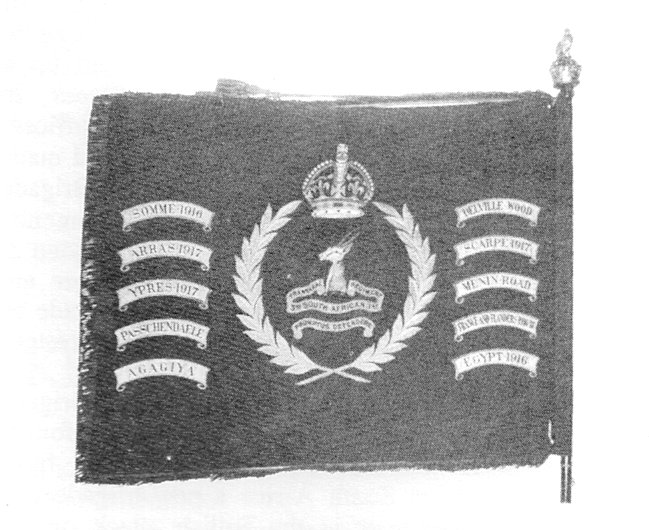

 The South African
The South African
(incorporating Museum Review)
by R Henry
During closed order battle, the Colour became the rallying point for confused troops. The loss or capture of the Colour was a considerable disgrace; conversely, the capture of the enemy's Colour was an extraordinary honour. Thus, officers and men would rather tear their Colour apart and distribute it among the men, than have it fall into enemy hands. The Regimental Colour today links together the past, present and future members of the regiment.
With the presentation in 1904 of King's Colours by the Princess Christian to 27 regiments and units for services rendered during the Anglo Boer War, the right to Colours for South African units became more firmly established. With the outbreak of the First World War (1914-1918), the granting and presentation of official Colours in South Africa was brought to a standstill. However, during the war years there was a movement towards the provision of unofficial flags of varying types for units raised specifically for service in the war. The South African National Museum of Military History in Saxonwold, Johannesburg, is in possession of the unofficial Colour of the 8th South African Infantry Regiment.
Under the command of Lieutenant-Colonel Edward Francis Thackwray, the 3rd South African Infantry Regiment, consisting of men from the Transvaal and Rhodesia, left the Union for England in September 1915. After acquitting themselves well in the battles of the Western Front, they were disbanded on 18 February 1918, owing to a lack of manpower.
Following the cessation of hostilities, the South African Government decided to provide a Regimental Colour for each of the four regiments in the 1St South African Brigade, including Thackwray's 3rd South African Infantry Regiment. In 1920, the South African High Commissioner in London was asked to obtain these Colours. They were duly manufactured, but were not delivered because the question of Battle Honours had not yet been resolved. This was eventually accomplished in 1926 and the Colours, with the Battle Honours affixed, arrived in South Africa in December 1926.
The 3rd South African Infantry were awarded eleven battle or campaign honours, but were only allowed to display ten of these on their Regimental Colour in accordance with Army Order 470 of 1922.

The Regimental Colour of the 3rd South African
Infantry
(SA National Museum of Military History).
As the regiments of the 1st South African Brigade had been disbanded long before the arrival of their Colours in South Africa, it was obvious that their former commanding officers and regimental associations would be responsible for receiving the Colours and arranging for their suitable laying-up. This was duly done and the Regimental Colour of the 3rd South African Infantry was placed in the All Souls Chapel of St Mary the Virgin Cathedral in Johannesburg.
In 1989, the interior of the cathedral was refurbished and the Colours were taken down. At this point, the Dean of Johannesburg, the Reverend Henwood, approached the SA National Museum of Military History and requested that the museum remove the colours, as their retention of the Colours was felt to be inappropriate by the cathedral authorities. The museum agreed to accept the Colours on the condition that they were properly deconsecrated. However, as some of the Colours belonged to units still in existence these units were consulted and asked to collect their Colours and to arrange for them to be suitably laid up. These regiments then removed their Colours, leaving behind those which belonged to the disbanded units. At this point, the museum decided to remove the remaining Colours to ensure their preservation for future generations, in spite of the fact that they had not been deconsecrated. In a sense, the museum's action was prompted by the motto of the 3rd South African Regiment: promptus defendere (ready to defend). In this case, it was the Regimental Colour which was to be defended. The Colour of the 3rd South African Regiment can be viewed on display in one of the halls at the museum.
Return to Journal Index OR Society's Home page